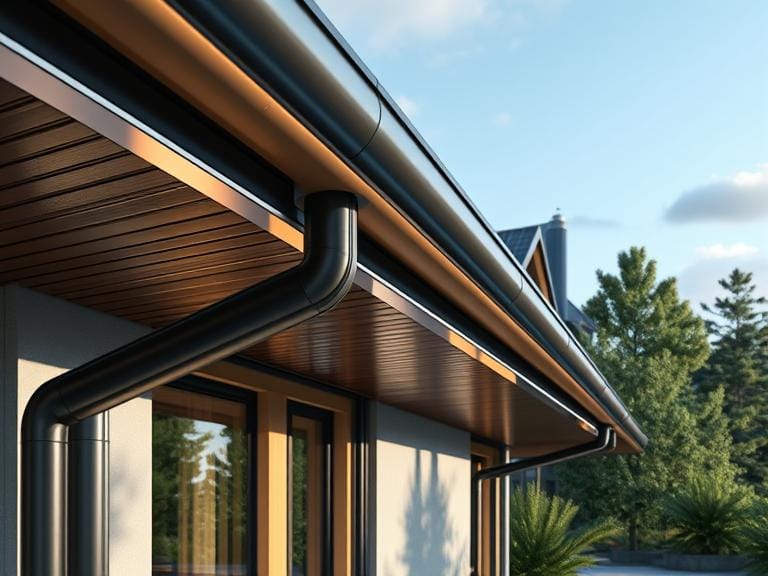The Cost of Ignoring Eavestrough Maintenance
Eavestroughs, commonly referred to as gutters, play a critical role in managing rainwater runoff from rooftops. These systems are designed to channel rainwater away from the foundation of a building, thereby protecting the structural integrity of the property. Properly functioning eavestroughs are essential for maintaining a dry basement and preventing soil erosion around the home. When rainwater is not directed away efficiently, it can accumulate near the foundation, leading to potential water damage that is both costly and difficult to repair.
Moreover, eavestroughs contribute significantly to the longevity of various building materials. Excess water exposure can lead to wood rot, rust, and deterioration of siding, which not only mar the aesthetic appeal of a home but can also compromise its structural strength. By ensuring that these gutters are free from debris and clogs, homeowners can mitigate the risk of mold and mildew growth, which thrive in damp environments and can pose health risks to occupants.
Routine maintenance of eavestroughs includes regular cleanings, which may involve the removal of leaves, twigs, and other debris that can obstruct the flow of water. This preventive care is crucial, especially during seasons of heavy rainfall or in regions prone to storms. Homeowners should periodically check for signs of wear, such as leaks or sagging, as neglecting such issues can result in extensive damage over time. Thus, understanding the significance of eavestroughs is pivotal for maintaining the overall health of a home and safeguarding it against the detrimental effects of water accumulation.
Consequences of Neglecting Eavestrough Maintenance
Failing to maintain eavestroughs can result in a variety of serious consequences that affect both the structural integrity of a home and the health of its occupants. One of the most prominent issues arising from neglected eavestroughs is water damage to the foundation. When eavestroughs become clogged with debris, such as leaves and twigs, rainwater cannot flow away from the base of the house. This accumulation of water can lead to soil erosion, increased hydrostatic pressure against the foundation walls, and ultimately, cracks or shifts in the foundation, necessitating costly repairs.
In addition to foundation issues, unresolved eavestrough problems can create ideal conditions for pest infestations. Standing water due to poorly functioning eavestroughs can attract insects like mosquitoes, which not only become a nuisance but can also pose health risks. Furthermore, pests such as rodents and termites may find shelter in damp areas, leading to further damage and a potential increase in extermination costs for homeowners.
Moreover, the lack of proper eavestrough maintenance often results in the growth of mold and mildew. When rainwater overflows from blocked eavestroughs, it can seep into walls and ceilings, creating a damp environment. This moisture-rich setting encourages the proliferation of mold, which can severely impact air quality and lead to various health issues, including respiratory problems and allergic reactions.
Several case studies illustrate the direct consequences of neglecting eavestrough maintenance. For instance, a homeowner who ignored regular cleaning found that water pooled near their foundation, ultimately leading to significant structural damage. They faced repair costs upwards of $20,000 due to failing to address what began as a minor maintenance issue. Such examples underscore the importance of prioritizing eavestrough upkeep to avoid these significant financial repercussions.

Cost Analysis: What Ignoring Eavestrough Maintenance Could Mean for Your Wallet
Neglecting eavestrough maintenance can result in significant financial consequences for homeowners. The primary purpose of eavestroughs, or gutters, is to direct rainwater away from the foundation of a house. However, when they are not properly maintained, the resulting overflow and damage can lead to extensive and costly repairs.
The average annual cost of maintaining eavestroughs generally ranges from $100 to $300, depending on factors such as the size of the home and the extent of maintenance needed. In contrast, the expenses incurred from neglecting such maintenance can escalate into thousands of dollars. For instance, water pooling around the foundation due to malfunctioning gutters can lead to foundation repairs, which average between $2,000 and $7,000. This expenditure could be avoided with timely inspections and cleaning of eavestroughs, potentially saving homeowners a considerable amount over time.
Moreover, the absence of eavestrough upkeep can also foster an environment for mold growth. Mold remediation services can cost anywhere from $500 to $3,000, particularly if it spreads to critical areas like walls and ceilings. Additionally, stagnant water from clogged eavestroughs can attract pests, necessitating pest control measures that typically range from $150 to $500 per treatment. These costs, when compared to regular eavestrough maintenance, underscore the importance of preventive care.
In the long run, investing in eavestrough maintenance not only protects a homeowner’s property but also safeguards their finances. Ensuring that these essential components of a home are functioning properly can prevent the need for costly repairs, demonstrating that the seemingly minor expense of maintenance is far less burdensome than remedial actions taken after damage occurs.
Practical Tips for Eavestrough Maintenance
Maintaining eavestroughs, commonly known as gutters, is crucial for the integrity of your home. Regular maintenance not only prevents damage but can also save homeowners significant repair costs over time. One of the most vital practices is to clean your eavestroughs at least twice a year—ideally in the spring and fall. During these seasonal check-ups, clear out leaves, twigs, and other debris that may obstruct water flow. Neglecting this simple task can lead to overflow, which may damage your roof and foundation.
In addition to regular cleaning, homeowners should be vigilant about inspecting their eavestroughs for signs of damage. Look for sagging sections, cracks, or areas where water doesn’t drain properly. These issues can signal the need for immediate attention. Noticing water pooling around the foundation of your home is another red flag that can indicate clogged or damaged eavestroughs. If you observe these signs, it may be time to repair or replace sections of your gutter system to avoid more extensive and costly damage.
It’s also wise to consider professional assistance for maintenance. If you are uncomfortable with heights or lack the necessary equipment, it is advisable to hire a professional service. They possess the expertise and tools needed to thoroughly inspect and maintain eavestroughs safely. Moreover, professionals typically offer warranties on their services, providing you with peace of mind that your gutters are in capable hands. Implementing these practical tips can significantly enhance the longevity and functionality of your eavestroughs, ensuring that your home remains protected from water-related issues.







